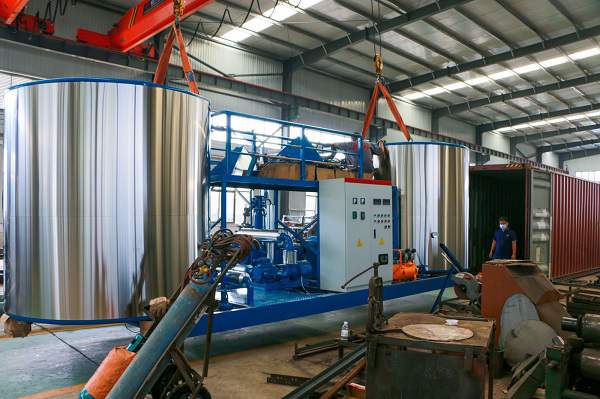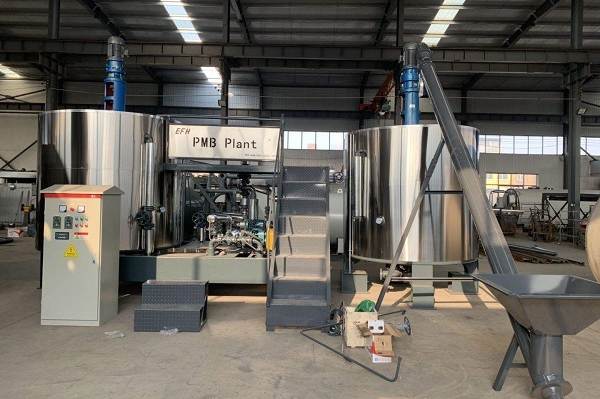Modified bitumen refers to an asphalt mixture with the addition of rubber, resin, high molecular polymer, finely ground rubber powder and other modifiers, or the use of mild oxidation processing of bitumen to improve the performance of the bitumen. The pavement paved with it has good durability and abrasion resistance, and does not soften at high temperatures or crack at low temperatures.


The excellent performance of modified bitumen comes from the modifier added to it. This modifier can not only merge with each other under the action of temperature and kinetic energy, but also react with bitumen, thus greatly improving the mechanical properties of bitumen. just like adding steel bars to concrete. In order to prevent the segregation that may occur in general modified bitumen, the bitumen modification process is completed in a special mobile equipment. The liquid mixture containing bitumen and modifier is passed through a colloid mill full of grooves. Under the action of the high-speed rotating colloid mill, the molecules of the modifier are cracked to form a new structure and then are lased to the grinding wall and then bounce back, evenly mixed into the bitumen. This cycle repeats, which not only makes the abitumen and the The modification achieves homogenization, and the molecular chains of the modifier are pulled together and distributed in a network, which improves the strength of the mixture and enhances the fatigue resistance. When the wheel passes over the modified bitumen, the bitumen layer undergoes corresponding slight deformation. When the wheel passes over, due to the strong bonding force of the modified bitumen to the aggregate and good elastic recovery, the squeezed part quickly returns to flatness. original condition.
Modified bitumen can effectively enhance the load capacity of the pavement, reduce pavement fatigue caused by overloading, and exponentially extend the service life of the pavement. Therefore, it can be widely used in the paving of high-grade highways, airport runways, and bridges. In 1996, modified bitumen was used to pave the east runway of Capital Airport, and the road surface remains intact to this day. The use of modified bitumen in permeable pavements has also attracted much attention. The void rate of permeable pavement can reach 20%, and it is internally connected. Rainwater can be quickly drained from the pavement on rainy days to avoid slipping and splashing when driving. In particular, the use of modified bitumen can also reduce noise. On roads with relatively large traffic volumes, this structure shows its advantages.
Due to factors such as large temperature differences and vibrations, many bridge decks will shift and crack soon after use. The use of modified bitumen can effectively solve this problem. Modified bitumen is an indispensable ideal material for high-grade highways and airport runways. With the maturity of modified bitumen technology, the use of modified bitumen has become the consensus of countries around the world.
 Albanian
Albanian  Russian
Russian  Arabic
Arabic  Amharic
Amharic  Azerbaijani
Azerbaijani  Irish
Irish  Estonian
Estonian  Odia (Oriya)
Odia (Oriya)  Basque
Basque  Belarusian
Belarusian  Bulgarian
Bulgarian  Icelandic
Icelandic  Polish
Polish  Bosnian
Bosnian  Persian
Persian  Afrikaans
Afrikaans  Tatar
Tatar  Danish
Danish  German
German  French
French  Filipino
Filipino  Finnish
Finnish  Frisian
Frisian  Khmer
Khmer  Georgian
Georgian  Gujarati
Gujarati  Kazakh
Kazakh  Haitian Creole
Haitian Creole  Korean
Korean  Hausa
Hausa  Dutch
Dutch  Kyrgyz
Kyrgyz  Galician
Galician  Catalan
Catalan  Czech
Czech  Kannada
Kannada  Corsican
Corsican  Croatian
Croatian  Kurdish (Kurmanji)
Kurdish (Kurmanji)  Latin
Latin  Latvian
Latvian  Lao
Lao  Lithuanian
Lithuanian  Luxembourgish
Luxembourgish  Kinyarwanda
Kinyarwanda  Romanian
Romanian  Malagasy
Malagasy  Maltese
Maltese  Marathi
Marathi  Malayalam
Malayalam  Malay
Malay  Macedonian
Macedonian  Maori
Maori  Mongolian
Mongolian  Bengali
Bengali  Myanmar (Burmese)
Myanmar (Burmese)  Hmong
Hmong  Xhosa
Xhosa  Zulu
Zulu  Nepali
Nepali  Norwegian
Norwegian  Punjabi
Punjabi  Portuguese
Portuguese  Pashto
Pashto  Chichewa
Chichewa  Japanese
Japanese  Swedish
Swedish  Samoan
Samoan  Serbian
Serbian  Sesotho
Sesotho  Sinhala
Sinhala  Esperanto
Esperanto  Slovak
Slovak  Slovenian
Slovenian  Swahili
Swahili  Scots Gaelic
Scots Gaelic  Cebuano
Cebuano  Somali
Somali  Tajik
Tajik  Telugu
Telugu  Tamil
Tamil  Thai
Thai  Turkish
Turkish  Turkmen
Turkmen  Welsh
Welsh  Uyghur
Uyghur  Urdu
Urdu  Ukrainian
Ukrainian  Uzbek
Uzbek  Spanish
Spanish  Hebrew
Hebrew  Greek
Greek  Hawaiian
Hawaiian  Sindhi
Sindhi  Hungarian
Hungarian  Shona
Shona  Armenian
Armenian  Igbo
Igbo  Italian
Italian  Yiddish
Yiddish  Hindi
Hindi  Sundanese
Sundanese  Indonesian
Indonesian  Javanese
Javanese  Yoruba
Yoruba  Vietnamese
Vietnamese  Hebrew
Hebrew  Chinese (Simplified)
Chinese (Simplified)






.jpg)
